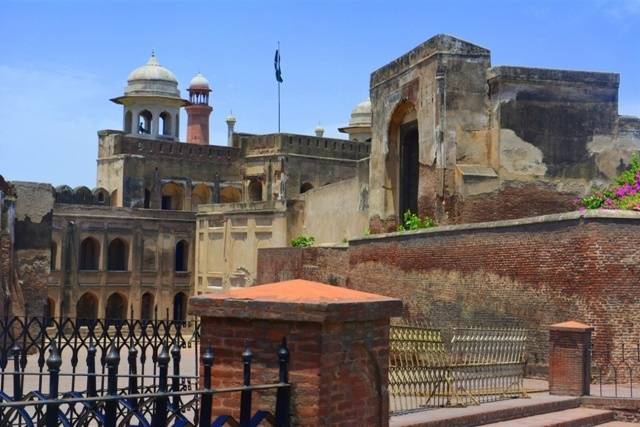
Lahore Fort is one of the noblest structures of its kind in the world. Rising out of the northwest corner of the walled city, it has been a symbol of its earliest days. If it could speak, it would tell such things that would leave the listener breathless. It could tell of love, romance and adventure, of dark eyed beauties and fierce-browed warriors, of queens in flowing silks and kings in shining armour, of poets, actors, slaves and concubines, of soldiers and rebels, of revolutions and court intrigues, of coronations and assassinations, of treachery and black revenge.
The Lahore fort, also known as Shahi Qila, is a reflection of many centuries. The earliest reference to the fort comes in a history of Lahur (Lahore) compiled by Al-Biruni, which refers to a fort constructed in the early 11th century. He further notes that Munshi Sujan Rae Bhandari, author of the Khulasatut Tawarikh in 1695-96 A.D., records that Malik Ayaz, a favorite of Sultan Mahmud, built a masonry fort at Lahore and repopulated the city.
Khan believes it is the same fort that was destroyed by the Mongols in 1241 and in 1398 by a detachment of Timur's army after which it was rebuilt again in 1421 by Sayyid, son of Khizr Khan.
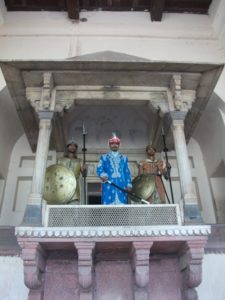 Mughal emperor Akbar demolished the earlier mud fort, and re-built it in burnt brick in 1566. Akbar's successors, Jahangir, Shah Jahan and Aurangzeb added several buildings to the fort and made majestic additions.
Mughal emperor Akbar demolished the earlier mud fort, and re-built it in burnt brick in 1566. Akbar's successors, Jahangir, Shah Jahan and Aurangzeb added several buildings to the fort and made majestic additions.
Though irregular in scheme the fort measures about 427 meters east-west and 335 meters north-south excluding the fortification wall added later during the Sikh rule of Maharaja Ranjit Singh (1799 – 1839 A.D). It is enclosed within a strong fortification wall, built in small burnt bricks. It is said that this was the fort made by Ghaznavids with mud but when Akbar, the Mughal Emperor took over the power, he made it with burnt bricks and we see that till now.
The main gates are located in the middle of the east and the west walls. A gateway, providing access to the private apartment of the royalty, exists in the northwest corner. The fort was essentially a fortress-palace, but it also served as an abode for royal treasury, and a stronghold in the event of war. This fort was much used as a leisure place during the Mughal rule, but as the Sikhs and British came there, the fort was changed into soldier barracks and for war purposes.
After the fall of the Mughal dynasty in the Punjab, in the 18th century, the Sikhs occupied the Fort. Maharaja Ranjit Singh added several pavilions on the upper ramparts. He also added his room in the heart of fort which was Sheesh Mahal. Outside this palace of mirrors, he added Ath Dara where he used to hold his court.
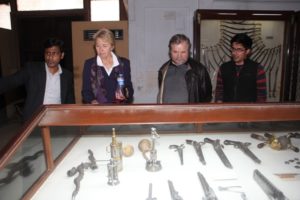
Similarly, Kharak Singh’s and Rani Jindan’s havelis were added in the Jahangir’s Quadrangle. Moti Masjid was turned into a temple and renamed Moti Mandir. Later, the mosque was used as a building for the state treasury. The royal kitchen was turned into food storage and horse stable. The gilt frescos paintings on its northern wall made by Maharaja Ranjit’s court artists reflect the style of Kangra School (legend of Krishna) of painting all around that speak loudly of its relation with Sikh period.
In 1849, the fort came under the British military occupation. Modifications to the fort were made during the British colonial period, but consisted mainly of converting older buildings into hospitals, barracks, and other colonial functions. The use of various places in Lahore fort was changed and a Royal Jail was also established there. During the British rule, more additions were made to the Deewna-e-Aam. It was turned into a hospital and dispensary. The main wall at different parts was extended thus blocking the view of the picture wall and the Badshahi Mosque.
The British jail was constructed for the prisoners and the royal kitchens were turned into prison cell. Another storey was added for the residences of the officers and police. Similarly, Emperor Jahangir’s Sleeping chamber was converted into a dining hall and the haram was converted into the guest houses. The kitchens for the British were built on the roof top of Deewan-e-Aam.
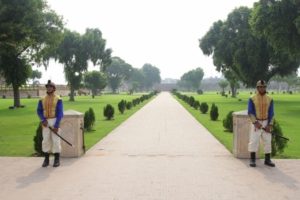
In 1899, on the orders of Lord Curzon the viceroy of sub-continent, the Moti Masjid was restored to its former status, and some of the religious remnants were preserved at the Badshahi Mosque.
The fort has almost 21 different buildings in it. Those lying in the northern half are grouped in four blocks or quadrangles. Lahore fort is the only monument in Pakistan, which represents a complete history of Mughal architecture and the eras following it. The architecture of Akbar’s period in the fort is characterised mainly by the use of red sand stone, and cut brick work.
The use of animal figures such as lion, elephant and peacock as well as sculptured gargoyle, as brackets to support the chajja of dalans (eaves of chambers) in Jahangir’s Quadrangle shows the Hindu elements used in the Mughal architecture of Akbar and Jahangir’s period. The buildings of Shah Jahan and Aurangzeb periods provide a striking contrast with the former. The use of marble in place of red sand stone, and exuberance of the Persian motifs, pietra-dura and glazed tile mosaic work, are the chief characteristics of the buildings added by Shah Jahan, the prince architect of South-East Asia.
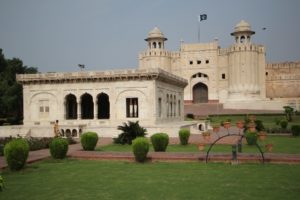
Lahore Fort was enlisted among the World Heritage Sites in 1981 by UNESCO (United Nations Educational, Scientific and Cultural Organisation).
Today Lahore Fort has become a much-loved and adored tourist spot as many changes have been made in it by the Walled City of Lahore Authority. Most of the no go areas have been restored and opened for the tourists which astonish the visitors.
I will share more interesting facts about the Lahore Fort in the next part of the article. Stay tuned!
